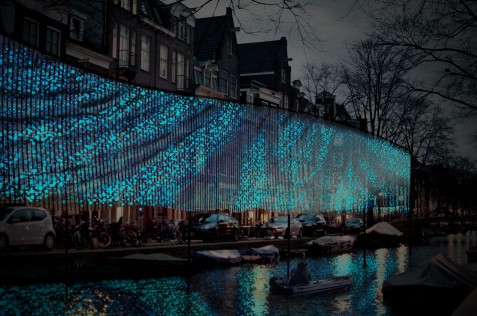GRAD_2017
Hoe leg je natuurlijke fenomenen vast? Jonathan Gaarthuis is gefascineerd door vaste en vloeibare materie. Zijn werk biedt ons een inkijk in de altijd bewegende, bijna ongrijpbare materie die ons omringt: stof, water en licht. Zijn werktuigen zijn tijd en ruimte. De installatie Stofmachine (2010) bijvoorbeeld zuigt het onzichtbare stof aan waarmee wij zijn omringd (en zelf niet in het minst aan bijdragen); de niet geringe opbrengst wordt zichtbaar gemaakt op een filter. Zijn Raam installatie (2010) biedt eveneens een continue veranderend beeld: druppels condens trekken steeds opnieuw sporen op het glazen beeldvlak. Zijn fotoserie Lichtinterval is het resultaat van experimenten met licht. Op diverse manieren ‘vangt’ Gaarthuis het licht op fotopapier, waarmee het op analoge wijze wordt vereeuwigd.
Optica is een installatie die continu in beweging is. Hangende lamellen bewegen op en neer zodat er een lichtspel ontstaat.
A picture from the Gulf of Alaska that has been making the rounds on the Internet for the last few years — though particularly in recent weeks — shows a strange natural phenomenon that occurs when heavy, sediment-laden water from glacial valleys and rivers pours into the open ocean. There in the gulf, the two types of water run into each other, a light, almost electric blue merging with a darker slate-blue.
Informally dubbed “the place where two oceans meet,” the explanation for the photo is a simple one, though there are many misconceptions about it, including that catchy title. In particular on popular link-sharing website Reddit, where users have on multiple occasions erroneously attributed the photo’s location as “Where the Baltic and North Sea meet” and the two types of water as being completely incapable of ever mixing, instead perpetually butting against each other like a boundary on a map.
A picture from the Gulf of Alaska that has been making the rounds on the Internet for the last few years — though particularly in recent weeks — shows a strange natural phenomenon that occurs when heavy, sediment-laden water from glacial valleys and rivers pours into the open ocean. There in the gulf, the two types of water run into each other, a light, almost electric blue merging with a darker slate-blue.
Informally dubbed “the place where two oceans meet,” the explanation for the photo is a simple one, though there are many misconceptions about it, including that catchy title. In particular on popular link-sharing website Reddit, where users have on multiple occasions erroneously attributed the photo’s location as “Where the Baltic and North Sea meet” and the two types of water as being completely incapable of ever mixing, instead perpetually butting against each other like a boundary on a map.
Deze installatie is net zo onvoorspelbaar als het Nederlandse weer. Wanneer de wind het kunstwerk - dat uit een sluier van duizenden leds bestaat - raakt, licht het kunstweer op, waardoor een natuurlijke kracht die normaal onzichtbaar is, zichtbaar wordt gemaakt.
Benthem Crouwel Architects en van der Wiel werden geïnspireerd door de zeevonken die de Nederlandse kunst doen oplichten. Deze eencelligen veroorzaken een intrigerende gloed en het is precies deze bioluminescentie waarop Lightwaves gebaseerd is.
Het gebruikelijke discours over natuurlijke fenomenen is dat we onszelf ertegen moeten beschermen. We gebruiken bijvoorbeeld airconditioning om onszelf te beschermen tegen hitte, windschermen om onszelf te beschermen tegen harde wind en verwarming om onszelf te beschermen tegen vorst. Lightwaves demonstreert dat natuurlijke fenomenen gebruikt kunnen worden om nieuwe vormen van architectuur te ontwikkelen die reageren op de omgeving.

Jonathan Gaarthuis - Lichtinterval 2013
www.jonathangaarthuis.nl
Lightwaves - Benthem Crouwel Architects en Jólan van der Wiel
Gulf of Alaska
Lightwaves - Benthem Crouwel Architects en Jólan van der Wiel
....
https://www.ted.com/talks/olafur_eliasson_playing_with_space_and_light?language=nl
Gulf of Alaska